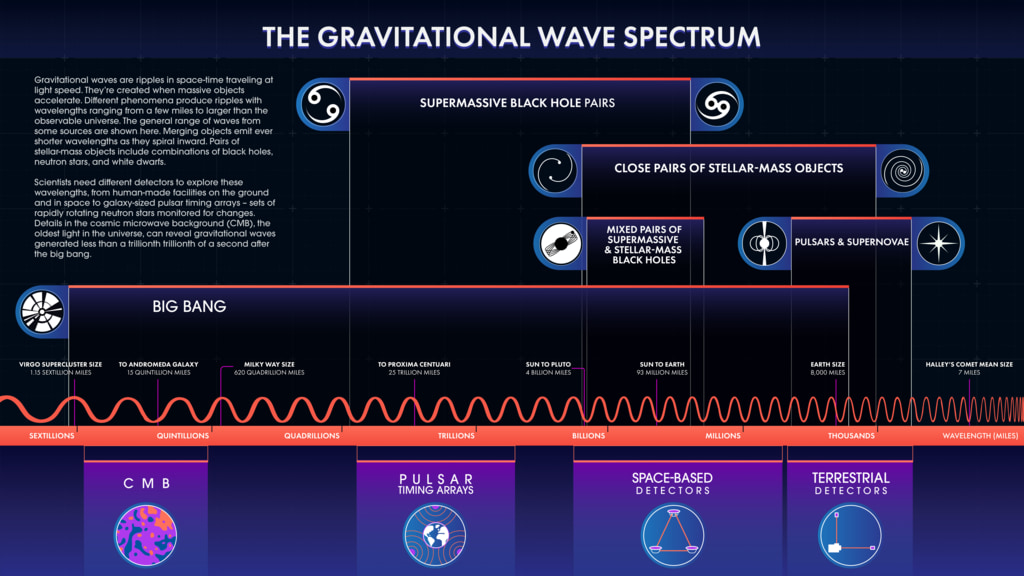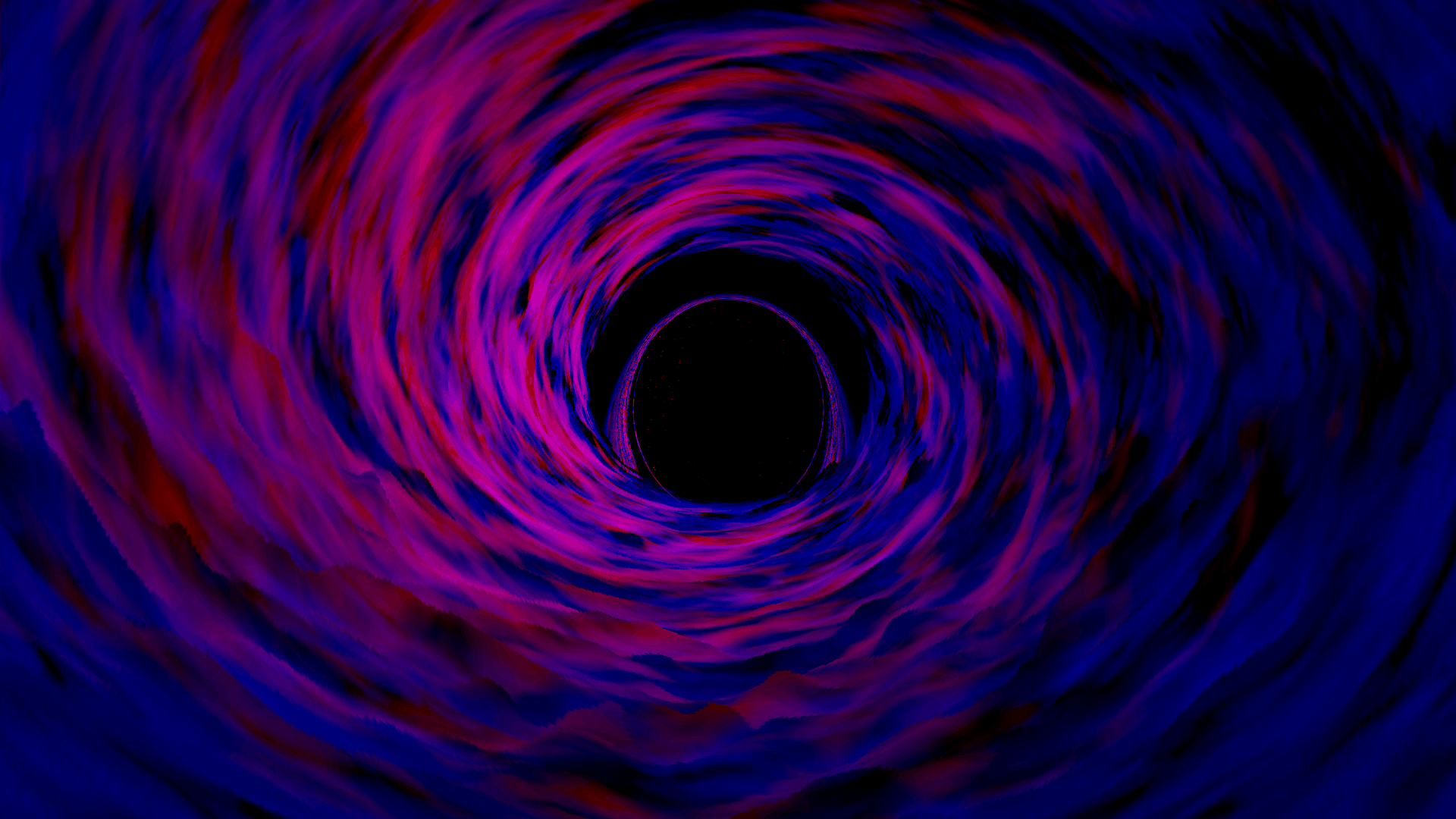Supermassive Black Hole Binary Simulation Visualizations in 4k
Simulation of the light emitted by a supermassive black hole binary system where the surrounding gas is optically thin (transparent). Viewed from 0 degrees inclination, or directly above the plane of the disk. The emitted light represents all wavelengths.
Credit: NASA's Goddard Space Flight Center/Scott Noble; simulation data, d'Ascoli et al. 2018
This new ultra-high definition simulation shows three orbits of a pair of supermassive black holes only 40 orbits from merging. The models reveal the light emitted at this stage of the process may be dominated by UV light with some high-energy X-rays, similar to what’s seen in any galaxy with a well-fed supermassive black hole.
Three regions of light-emitting gas glow as the black holes merge, all connected by streams of hot gas: a large ring encircling the entire system, called the circumbinary disk, and two smaller ones around each black hole, called mini disks. All these objects emit predominantly UV light. When gas flows into a mini disk at a high rate, the disk’s UV light interacts with each black hole’s corona, a region of high-energy subatomic particles above and below the disk. This interaction produces X-rays. When the accretion rate is lower, UV light dims relative to the X-rays.
The simulation is of a system with 1 million times the Sun's mass, and a separation between the two supermass black holes of 30 million kilometers.
The simulation ran on the National Center for Supercomputing Applications’ Blue Waters supercomputer at the University of Illinois at Urbana-Champaign. Modeling three orbits of the system took 46 days on 9,600 computing cores.
Simulation of the light emitted by a supermassive black hole binary system where the surrounding gas is optically thin (transparent). Viewed from 72 degrees inclination, or partially angled above the plane of the disk. The emitted light represents all wavelengths.
Credit: NASA's Goddard Space Flight Center/Scott Noble; simulation data, d'Ascoli et al. 2018
Simulation of the light emitted by a supermassive black hole binary system where the surrounding gas is optically thin (transparent). Viewed from 90 degrees inclination, or directly in line with the plane of the disk. The emitted light represents all wavelengths.
Credit: NASA's Goddard Space Flight Center/Scott Noble; simulation data, d'Ascoli et al. 2018
Simulation of the light emitted by a supermassive black hole binary system where the surrounding gas is optically thin (transparent). Viewed from 0 degrees inclination, or directly above the plane of the disk. The emitted light represents all wavelengths. This version uses frame interpolation to slow it down to one-quarter speed.
Credit: NASA's Goddard Space Flight Center/Scott Noble; simulation data, d'Ascoli et al. 2018
Simulation of the light emitted by a supermassive black hole binary system where the surrounding gas is optically thin (transparent). This view freezes the simulation and rotates it through 180 degrees, from directly above the plane of the disk to directly below.
Credit: NASA's Goddard Space Flight Center/Scott Noble; simulation data, d'Ascoli et al. 2018
Simulation of the light emitted by a supermassive black hole binary system where the surrounding gas is optically thin (transparent). This view freezes the simulation and rotates it through 360 degrees, while viewed in-line with the plane of the disk.
Credit: NASA's Goddard Space Flight Center/Scott Noble; simulation data, d'Ascoli et al. 2018
Simulation of the light emitted by a supermassive black hole binary system where the surrounding gas is optically thick (opaque). Viewed from 0 degrees inclination, or partially angled above the plane of the disk. The emitted light represents only ultraviolet.
Credit: NASA's Goddard Space Flight Center/Scott Noble; simulation data, d'Ascoli et al. 2018
Simulation of the light emitted by a supermassive black hole binary system where the surrounding gas is optically thick (opaque). Viewed from 0 degrees inclination, or partially angled above the plane of the disk. The emitted light represents only X-ray.
Credit: NASA's Goddard Space Flight Center/Scott Noble; simulation data, d'Ascoli et al. 2018
For More Information
Credits
Please give credit for this item to:
NASA's Goddard Space Flight Center
-
Producer
- Scott Wiessinger (USRA)
-
Science writer
- Jeanette Kazmierczak (University of Maryland College Park)
-
Visualizer
- Scott Noble (USRA/U. Tulsa)
-
Scientist
- Scott Noble (USRA/U. Tulsa)
Release date
This page was originally published on Tuesday, October 2, 2018.
This page was last updated on Wednesday, May 3, 2023 at 1:46 PM EDT.
Series
This page can be found in the following series:Related papers
https://iopscience.iop.org/article/10.3847/1538-4357/aad8b4
https://iopscience.iop.org/article/10.3847/1538-4357/aad8b4


